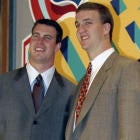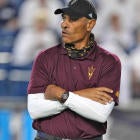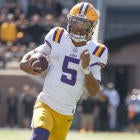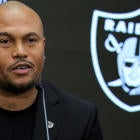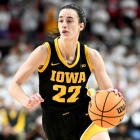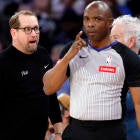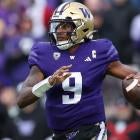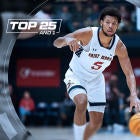
Death, taxes and quarterback busts. Thus is the NFL circle of life. In perhaps the greatest paradox in sports, the most important position is also the most difficult to draft and develop.
It's never been more critical to get it right, too. Roughly three-quarters of the NFL's starting quarterbacks are former first-round picks. Four top-shelf quarterback prospects will go near the top of the 2023 NFL Draft: Bryce Young, C.J. Stroud, Anthony Richardson and Will Levis. Maybe in that order. QBs might even go one-two-three-four for the first time in draft history.
Franchises will hitch their wagons to these four and fans will cast all their championship hopes on the shoulders of one player. The immense expectations will be completely unfair and unrealistic. It's the type of desperation that drove, say, Jets fans to prematurely nickname Mark Sanchez "Sanchise."
Living up to the 2020 class would be wishful thinking for teams set to draft a quarterback in April. Joe Burrow, Tua Tagovailoa, Justin Herbert and Jalen Hurts could ink extensions in excess of a combined one billion dollars this offseason.
On the opposite end of the spectrum, there's 2018. It's the only draft class where four QBs were selected in the top 10 between Baker Mayfield, Sam Darnold, Josh Allen and Josh Rosen. Three of those signal callers are already on their third team (or more).
If I'm drafting a QB in the first round, I'd like to know the chances of making a successful pick are at least a coin flip. Instead, it's closer to baseball, where batting .300 is considered a success.
In the 2010s, 37 percent of quarterbacks selected in the first round signed a second contract with the team that drafted them. I repeat. 37 percent!
Longtime NFL GM and CBS Sports Analyst Rick Spielman translates. "That tells you how hard it is to fill that position. If everyone thought Patrick Mahomes would be Patrick Mahomes coming out of Texas Tech, he would have been the first overall pick in the draft."
Indeed. What makes the draft so perplexing, is the long list of haunting hindsight is 20-20 moments that were not so clear cut at the time. That list now starts with Mitchell Trubisky over Mahomes. Browns fans will also never forget taking Kellen Winslow Jr. over Ohio native Ben Roethlisberger. How about the 49ers taking Alex Smith over Aaron Rodgers?
Scouting reports and media takes also provide a lengthy blooper reel. An AFC scout once said of Rodgers, "I don't like him. He's a clone of (Joey) Harrington and (Kyle) Boller. They all throw the same way".
A Chargers scout wanted to see Lamar Jackson work out at wide receiver.
An anonymous scout once said of Joe Montana, "doesn't have great tools, could eventually start."
During the 1983 NFL Draft broadcast, one analyst said of Dan Marino's pick to the Dolphins, "I just don't understand it ... I don't know where he's going to get this great coaching that is going to overcome the problems he's had."
One media outlet called the 2012 Russell Wilson pick "by far the worst move of the draft."
An NFL draft expert once said he would retire in eight years if Jimmy Clausen wasn't a successful NFL quarterback. Credit to him, he has a sense of humor about it and laughs at the Clausen bit seemingly every year.
You win some and you lose a lot more when it comes to the impossible task of drafting QBs. Tom Brady was the seventh QB taken in 2000 and won seven rings. It's hard to believe the most successful career in NFL history came from that NFL combine photo.
.@TomBrady's infamous NFL combine picture celebrates 20 years this week 🤣 pic.twitter.com/DdXlozxyvR
— ESPN (@espn) February 26, 2020
The margin between success and failure is razor thin and unforgiving. One pick can separate an all-time great and all-time bust. In 1998, Peyton Manning and Ryan Leaf went one-two. Manning won more MVPs (five) than Leaf played seasons (four) in the NFL. It doesn't matter who goes first either. One year later, Tim Couch and Donovan McNabb went one-two.
If you're an NFL team, you have to block out the noise. Don't let Zach Wilson's viral pro day throw or the legend of JaMarcus Russell throwing 70 yards from his knees fool you.
Spielman paints the challenging picture of drafting QBs by sharing what he witnessed at QB workouts in 2007 and 2008. "I remember I went to JaMarcus Russell's pro day at LSU and it may have been the best throwing workout I've ever seen. Big, strong, athletic, can throw the hell out of the ball. Can make all the throws. Then (the next year) I went to Matt Ryan's, the arm strength wasn't nearly as talented, some of the balls wobbled, accuracy was still great. But if you just went off the two pro days, it'd be night and day. you would take Russell over Matt Ryan."
Of course, evaluating QBs is not done in a vacuum, as Spielman can attest, "but then I also saw Matt Ryan play live, on a Thursday night at Virginia Tech in the rain. He didn't have any supporting cast around him. And he carried that team." An answer doesn't come as the result of one workout or test. Many factors are weighed heavily by a lot of bright people. Yet the success rate is still so low! 37 percent.
And admittedly, it's easy to cherry pick a few failures, so I'll go deeper. From a fan perspective, it seems like any criteria you would put faith into for evaluating your new quarterback leads to an equally lost list of boom and bust.
Let's go through a lot of the highly-touted QB prospects of the last few decades:
Production
When your favorite team drafts a quarterback, it's nice to know they had some college pedigree. Big numbers, big school and name recognition. Like your Bryce Young or C.J. Stroud. But for all the productive, big college QBs who pan out, there's the list that didn't.
| Boom | Bust |
|---|---|
Peyton Manning | Tim Tebow |
Joe Burrow | Jameis Winston |
Cam Newton | Johnny Manziel |
Andrew Luck | Marcus Mariota |
Carson Palmer | Sam Bradford |
Eli Manning | Matt Leinart |
Lamar Jackson | Tim Couch |
Side note: I still can't believe a Heisman QB has not won a Super Bowl for his draft team since Roger Staubach with the 1977 Cowboys.
Potential
If you're going near the top of the draft and haven't put up big numbers, you probably have considerable upside. Anthony Richardson and Will Levis have that and then some. We've seen so many high-upside prospects that have turned out either way.
| Boom | Bust |
|---|---|
Lamar Jackson | Zach Wilson |
Josh Allen | Paxton Lynch |
Jalen Hurts | JaMarcus Russell |
Justin Herbert | Ryan Leaf |
Michael Vick | Vince Young |
Patrick Mahomes | Blake Bortles |
Ryan Tannehill | Jeff George |
Measurables
Measurables might help you sleep at night. Your prototypical 6-foot-5, rocket-armed quarterback with massive hands is just as boom-or-bust as everyone else though.
| Boom | Bust |
|---|---|
Josh Allen | Paxton Lynch |
Justin Herbert | Blake Bortles |
Cam Newton | Jason Campbell |
Ben Roethlisberger | Blaine Gabbert |
Joe Flacco | Josh Freeman |
Andrew Luck | Byron Leftwich |
Joe Burrow | Ryan Leaf |
Matthew Stafford | Matt Leinart |
Donovan McNabb | JaMarcus Russell |
On the flip side, Spielman points out the myth on small quarterbacks has been debunked. "Can Bryce Young's size play? 10 years ago you'd say none of those guys could play. Now, all the sudden you have Drew Brees come through. That dispelled that. Then you have Russell Wilson."
Scouts
At the end of the day, you hope you can at least trust the scouts. Going through Scouts Inc. draft grades, for every Aaron Rodgers (99), there's a Matt Leinart (98) and Vince Young (97). And you can only scratch your head when you see grades like Dak Prescott (48) and Brock Purdy (31).
| Boom | Bust |
|---|---|
Aaron Rodgers (99) | Matt Leinart (98) |
Andrew Luck (99) | JaMarcus Russell (98) |
Matt Ryan (98) | Jameis Winston (97) |
Alex Smith (98) | Vince Young (97) |
Matthew Stafford (96) | Sam Bradford (97) |
Joe Burrow (94) | Blaine Gabbert (96) |
Cam Newton (93) | Mark Sanchez (95) |
Patience
Developing a QB is another animal, but getting a successful quarterback takes equal parts nature and nurture. You'd probably feel better about your QB situation if your team had the luxury of sitting your prospect as a rookie. Patience is constantly preached for rookie QBs in a world that has none to give. Either way, like the rest, the list of QBs who sit most (or all) of their rookie years sees about as much tragedy as triumph.
| Boom | Bust |
|---|---|
Aaron Rodgers | Jake Locker |
Patrick Mahomes | J.P. Losman |
Philip Rivers | Jason Campbell |
Carson Palmer | JaMarcus Russell |
Michael Vick | Johnny Manziel |
Chad Pennington | Paxton Lynch |
Daunte Culpeppers | Tim Tebow |
The environment a quarterback inherits should matter. A lot of people would point to Patrick Mahomes. He only started one game as a rookie behind Alex Smith. He entered the league with a great coaching staff led by Andy Reid and a nice supporting cast. Then how do you explain Paxton Lynch? The prototypical quarterback with a rocket arm, drafted by the defending Super Bowl-champion Broncos with ample weapons, a great defense, who starts four games in his career.
It's all head scratching. So WHY is evaluating and developing quarterbacks so hard? A front office can seemingly have it all figured out. They set their draft board, review medicals and intelligence tests, watch tape, talk to scouts and coaches, work with analytics, interview prospects, take them through a series of workouts and it's still not enough.
Some traits, like leadership, are simply harder to measure, as Spielman explains.
"When he's in the huddle. Those 11 guys are playing for the QB. And if they don't believe in that quarterback, that's an issue, like with the Jets this year."
Measurements are still evolving too. One of the biggest challenges is how to evaluate how quickly QBs process what they are seeing:
"You have to be able to process quickly," Spielman said. "So a guy can be extremely smart with everything that a coach installs on the board ... or you're sitting there watching tape and 'hey what's your adjustment here, if this safety rotates down, how are you going to go through your progressions if the defensive front changes or the back end of the defense changes?' And all the quarterbacks can sound extremely bright doing that, but where the mistake comes in ... Can they process all that in 2.5 seconds when they are on the field?"
That's not always easy to figure out, especially with the gap in the college and pro game. And there's no universal measure for this. "I don't know there's one set way that says, this is the right way to do that, or else someone would be making a gazillion dollars right now."
That seems to epitomize the entire process of drafting and developing quarterbacks. If anyone had a bulletproof system they'd be filthy rich. That system would certainly come in handy with the 2023 prospects, who all seem to have a trait that could make them, and another that could break them.
Bryce Young has the "it" factor, the production and pedigree at Alabama. The red flag, fair or not, is his size, measuring at 5-10, 204 pounds at the combine.
C.J. Stroud has the production and wowed scouts in Indianapolis with his throwing workout. Some have concerns about his ability to make off-schedule throws though.
Will Levis has all the arm talent in the world but questions surround his lack of production in college. Was it the result of a poor supporting cast or will questionable decision making follow him into the NFL?
And Anthony Richardson "won" the combine with a QB record vertical and broad jump to go along with a 4.43 40 time at 244 pounds. He's as polarizing a prospect as you'll find with ridiculous dual-threat upside, but comes with concerns about his accuracy.
The latter will be one of the biggest questions of the draft, says Spielman. "Can you improve accuracy? Now, Josh Allen, was he an exception to the rule?"
And perhaps the biggest question: Can anyone say with any certainty what the outcome of a quarterback selection will be?
If history has taught us anything, the answer is a resounding no. Perhaps that's what makes the draft the phenomenon that it is. The stakes couldn't be higher, and yet the results more closely resemble a lottery.












